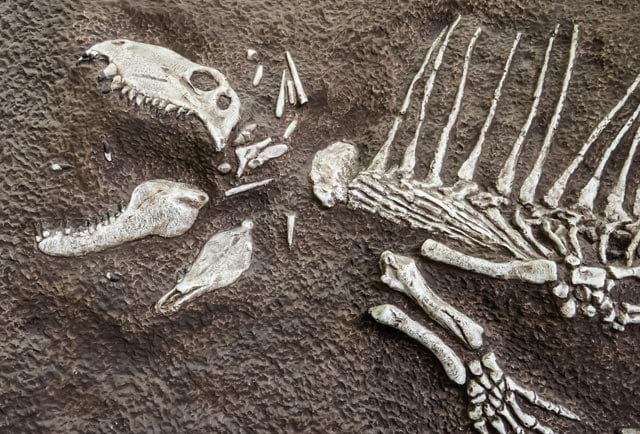
Just over 200 million years ago, the end-Triassic mass extinction killed off more than half of the species of organisms living on Earth’s land and in the oceans. We are only just beginning to understand how this – and the period of runaway global warming that followed – changed the chemistry of open oceans.
The end-Triassic mass extinction marked the transition between the Triassic to the Jurassic Period and the rise of the large herbivorous dinosaurs, such as the Diplodocus. The extinction meant that previously abundant species were cleared from ecological niches which allowed dinosaurs to move in with little competition from other animals. The Jurassic lasted another 55 million years until the beginning of the Cretaceous Period.
But the extinction also had profound effects on ocean ecosystems. Previous research linked the extinction to rapid global warming and changes in ocean chemistry which were caused by massive volcanic eruptions that released large amounts of greenhouse gasses into the atmosphere.
One of the unanswered questions has been how global warming changed the chemistry of the oceans. Some studies provide a picture of environmental changes on land and in coastal shallow seas, but until now there has been little information on the conditions of ecosystems in open ocean areas – known as pelagic zones – where water is neither close to the seabed or the shore.
We decided to investigate this unresolved problem, as open ocean settings better reflect global conditions in comparison to shallow coastal areas, as open oceans tend not to be subject to small climatic changes experienced by other areas such as shallow coastal regions near to shore.
Toxic oceans
We extracted and analysed fossilised organic molecules – known as biomarkers – that are the remains of microscopic marine organisms from sediments deposited at the bottom of what was the north-eastern Panthalassic Ocean – the vast body of water that surrounds the ancient super-continent Pangaea. The sediment is now preserved as rock exposed on the coast of Haida Gwaii (also known as the Queen Charlotte Islands) off the coast of British Columbia in Canada.
Different types of biomarkers signify the presence of certain groups of organisms and allow us to track their abundance in Triassic oceans. Our results show that for a 600,000-year interval immediately after the end-Triassic mass extinction, water close to the ocean surface became devoid of oxygen and was poisoned by hydrogen sulphide, a by-product of anaerobic bacteria that is extremely toxic to most other forms of life. This oxygen depletion and hydrogen sulphide poisoning disrupted the availability of nutrients, altering the food chains and causing a major disruption of marine ecosystems.
Clues for the future
These results are similar to another major event in the geologic record that was also caused by greenhouse gas release: the end-Permian extinction, the largest-known mass extinction.
Our team’s discoveries about the end-Triassic mass extinction event have direct relevance to today’s world because we are currently experiencing a rapid rise in the atmospheric levels of the greenhouse gas, carbon dioxide (CO2). Although the Earth was very different during the Triassic Period due to the lack of polar ice caps and higher initial CO2 concentrations, the speed of CO2 release from volcanic eruptions following the mass extinction is similar to those that we are experiencing today through the burning of fossil fuels.
The concern is that the consequences of rapidly rising atmospheric CO2 levels can be expected to be similar: ocean acidification, oxygen depletion of the oceans, hydrogen sulphide poisoning and disruption of food chains through the killing off of photosynthesisers in the ocean.
Studies of ancient mass extinctions such as the one at the end-Triassic inform us of the possible consequences of our own CO2 crisis.
We’re not backing down in the face of Trump’s threats.
As Donald Trump is inaugurated a second time, independent media organizations are faced with urgent mandates: Tell the truth more loudly than ever before. Do that work even as our standard modes of distribution (such as social media platforms) are being manipulated and curtailed by forces of fascist repression and ruthless capitalism. Do that work even as journalism and journalists face targeted attacks, including from the government itself. And do that work in community, never forgetting that we’re not shouting into a faceless void – we’re reaching out to real people amid a life-threatening political climate.
Our task is formidable, and it requires us to ground ourselves in our principles, remind ourselves of our utility, dig in and commit.
As a dizzying number of corporate news organizations – either through need or greed – rush to implement new ways to further monetize their content, and others acquiesce to Trump’s wishes, now is a time for movement media-makers to double down on community-first models.
At Truthout, we are reaffirming our commitments on this front: We won’t run ads or have a paywall because we believe that everyone should have access to information, and that access should exist without barriers and free of distractions from craven corporate interests. We recognize the implications for democracy when information-seekers click a link only to find the article trapped behind a paywall or buried on a page with dozens of invasive ads. The laws of capitalism dictate an unending increase in monetization, and much of the media simply follows those laws. Truthout and many of our peers are dedicating ourselves to following other paths – a commitment which feels vital in a moment when corporations are evermore overtly embedded in government.
Over 80 percent of Truthout‘s funding comes from small individual donations from our community of readers, and the remaining 20 percent comes from a handful of social justice-oriented foundations. Over a third of our total budget is supported by recurring monthly donors, many of whom give because they want to help us keep Truthout barrier-free for everyone.
You can help by giving today. Whether you can make a small monthly donation or a larger gift, Truthout only works with your support.